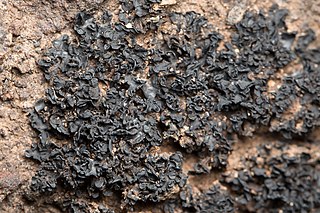The Gloeoheppiaceae are a family of ascomycete fungi in the order Lichinales. There are seven species in the family. Most species are lichenized with cyanobacteria. Species in this family are mostly found in desert areas. The family was circumscribed in 1995 by German lichenologist Aino Henssen.

The Lichinaceae are a family of ascomycete fungi. Most species are lichenized with cyanobacteria, and have a distribution largely in temperate regions.
Ainoa is a genus of lichens in the family Baeomycetaceae. The genus contains two species: A. mooreana, and the type, A. geochroa. The genus was circumscribed in 2001 by H. Thorsten Lumbsch and Imke Schmitt to contain the two species, which were formerly placed in genus Trapelia. A third species, Ainoa bella from eastern North America, was added to the genus in 2015.
Santessoniella is a genus of lichenized fungi in the family Pannariaceae. The classification reflects various changes made based on the Systema Ascomycetum and Myconet in the Deep Hypha issue of Mycologia.

Xanthoparmelia is a genus of foliose lichen in the family Parmeliaceae. Xanthoparmelia is synonymous with Almbornia, Neofuscelia, Chondropsis, Namakwa, Paraparmelia, and Xanthomaculina. This genus of lichen is commonly found in the United States, as well as Australia, New Zealand and Ecuador.
Lichinodium is a genus of filamentous lichens. It is the only genus in the family Lichinodiaceae, itself the only member of the order Lichinodiales. Lichinodium has four species. Previously considered part of the class Lichinomycetes, molecular phylogenetic analysis revealed that Lichinodium represents a unique lineage in the Leotiomycetes—the first known group of lichen-forming fungi in this class.
Stromatella bermudana is a saxicolous (rock-dwelling) crustose lichen. It is the only species in Stromatella, a monotypic fungal genus in the family Lichinaceae. The genus was circumscribed in 1989 by German lichenologist Aino Henssen. This species was originally described as Psorotichia bermudana by US botanist Lincoln Ware Riddle in 1916, from specimens collected in Bermuda.
Zahlbrucknerella is a genus of filamentous, rock-dwelling lichens in the family Lichinaceae.

Thyrea is a genus of lichen-forming fungi in the family Lichinaceae. It contains four species that have been accepted by Species Fungorum. The genus was circumscribed by Italian lichenologist Abramo Bartolommeo Massalongo in 1856, with Thyrea plectospora assigned as the type species.
Leightoniella is a fungal genus in the family Pannariaceae. This is a monotypic genus, containing the single species Leightoniella zeylanensis, a cyanolichen. The genus was circumscribed in 1965 by Norwegian lichenologist Aino Henssen. The generic name honours English clergyman and botanist William Allport Leighton, who originally described the type species in 1870 as Pterygium zeylanense.
Staurolemma is a genus of lichenized fungi in the family Pannariaceae. The genus was circumscribed by German lichenologist Gustav Wilhelm Körber in 1867, with Staurolemma dalmaticum as the type species.

Steinera is a genus of lichen-forming fungi in the family Koerberiaceae. It was circumscribed in 1906 by Austrian-Hungarian botanist Alexander Zahlbruckner, who dedicated the genus name to his friend Julius Steiner, an Austrian teacher and lichenologist. The genus was revised by Aino Henssen and Peter Wilfred James in 1982. In 2017, Damien Ernst and Roar Skovlund Poulsen described some new species, and recombined others into the genus based on a study of the genus in the subantarctic islands of Crozet and Kerguelen.
Hertella is a lichenized genus of fungi within the Placynthiaceae family.
Stephanocyclos is a genus of lichen-forming fungi in the family Lecideaceae. It is a monotypic genus, containing the single species Stephanocyclos henssenianus. This crustose lichen was formally described as a new species in 1983 by German lichenologist Hannes Hertel as part of a set of exsiccata. The type specimen was collected from volcanic rock found on Marion Island, one of the two Prince Edward Islands in the southern Indian Ocean. The specific epithet henssenianus honours lichenologist Aino Henssen.
Pulvinodecton is a genus of lichen-forming fungi in the family Roccellaceae. It has two species. The genus was circumscribed in 1998 by lichenologists Aino Henssen and Göran Thor, with Pulvinodecton kurzii assigned as the type species. Pulvinodecton differs from Erythrodecton in having spindle-shaped (fusiform) rather than doubly club-shaped (biclavate) ascospores, and by the development of its ascocarp. Additionally, the unusual pycnidia of Pulvinodecton species feature a deeply divided cavity with more than one ostiole.
Aino Marjatta Henssen, was a German lichenologist and systematist. Her father, Gottfried Henssen, was a folklorist and her mother was Finnish.

Roccellinastrum is a genus of lichen-forming fungi in the family Pilocarpaceae. It has seven species.
Lichinodium canadense is a species of minute fruticose (bushy) cyanolichen in the family Lichinodiaceae. It is found in British Columbia, Canada, where it grows on conifer bark.
Psoroglaena stigonemoides is a species of corticolous (bark-dwelling) lichen in the family Verrucariaceae. It occurs in Great Britain and Ireland. It was first described scientifically by lichenologist Alan Orange in 1989, as Macentina stigonemoides. He collected the type specimen from Cardiganshire, Cambria, where it was found growing on the bark of Ulmus glabra in a humid forest. Aino Henssen transferred it to the genus Psoroglaena in 1995.
Henssenia is a genus of lichen-forming fungi in the family Koerberiaceae. It has four species. The genus was circumscribed in 2017 by Damien Ertz, Roar Skovlund Poulsen, and Ulrik Søchting, with Henssenia glaucella assigned as the type species. The main distinguishing characteristic of the genus is simple ascospores that sometimes have a plasma bridge. The genus name honours German lichenologist Aino Henssen.




